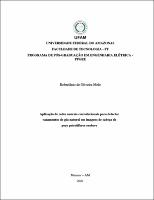| ???jsp.display-item.social.title??? |


|
Please use this identifier to cite or link to this item:
https://tede.ufam.edu.br/handle/tede/8598| ???metadata.dc.type???: | Tese |
| Title: | Aplicação de redes neurais convolucionais para detectar vazamentos de gás natural em imagens de cabeça de poço petrolíferos onshore |
| ???metadata.dc.creator???: | Melo, Roberlânio de Oliveira  |
| ???metadata.dc.contributor.advisor1???: | Costa Filho, Cícero Ferreira Fernandes |
| First advisor-co: | Costa, Marly Guimarães Fernandes |
| ???metadata.dc.contributor.referee1???: | Pereira, José Raimundo Gomes |
| ???metadata.dc.contributor.referee2???: | Xavier, Clahildek Matos |
| ???metadata.dc.contributor.referee3???: | Nakamura, Fabíola Guerra |
| ???metadata.dc.contributor.referee4???: | Oliveira, Jozias Parente de |
| ???metadata.dc.description.resumo???: | Grandes vazamentos de gás natural levam a acidentes que muitas vezes são letais para os humanos e altamente destrutivos para a propriedade, além de liberar metano na atmosfera, impactando negativamente nosso meio ambiente. Logo, a detecção de vazamentos de gás natural é uma ação importante da indústria do petróleo para a prevenção de acidentes. A literatura fornece diferentes técnicas para detecção de vazamentos de gás natural. Porém, com exceção de estudos anteriores desenvolvidos pelo autor desta tese sobre o tema, ainda existe uma lacuna na literatura sobre detecção de nuvens de vazamentos de gás natural por meio de imagens digitais, sem a necessidade de sensores ou câmeras especiais calibradas para o espectro de moléculas de metano. Nos estudos anteriores foram utilizadas técnicas de processamento de imagem associadas a um classificador de filtro de novidade para investigar a presença ou ausência de nuvem visível de vapores de hidrocarbonetos, ou seja, uma pluma de gás natural em quadros de circuito fechado de televisão instalados em cabeças de poços petrolíferos terrestres. Nesta tese, é apresentado um novo método de detecção de nuvens visível de vapores de hidrocarbonetos que é constituído de redes neurais convolucionais, as quais são aplicadas para classificar imagens (frames do circuito fechado de televisão) como pertencentes às classes com ou sem vazamento de gás natural em cabeças de poço onshore, aprimorando os resultados obtidos anteriormente. Com o objetivo de realizar a tarefa de detecção de vazamentos, o estudo propõe e apresenta o resultado de três arquiteturas de redes neurais convolucionais, além de investigar a técnica de transferência de conhecimento com as arquiteturas pré-treinadas DenseNet-201, GoogLeNet, MobileNetV2 e ResNet-18, e também a técnica de Feature Fusion aplicada a estes modelos pré-treinados. O estudo fornece ainda uma explicação visual provendo a região da imagem de entrada que foi relevante para o classificador tomar a decisão de que ocorreu um vazamento, através da técnica Gradient-weighted Class Activation Mapping. Os resultados experimentais mostraram que o modelo de melhor desempenho apresentou acurácia de 100,00% e taxa de falsos negativos de 0,00%, superando o desempenho de métodos anteriores de detecção de vazamento de gás natural por imagens de circuito fechado de televisão |
| Abstract: | Large natural gas leaks lead to accidents that often are lethal to humans and highly destructive to property, as well as release methane into the atmosphere, negatively impacting our environment. Therefore, the detection of natural gas leaks is an important action of the oil industry to prevent accidents. The literature provides different techniques for detecting natural gas leaks. However, except for previous studies proposed by the author of this thesis on the subject, there is still a gap in the literature on the detection of clouds of natural gas leaks through digital images, without the need for sensors or specific cameras calibrated for the spectrum of methane molecules. In previous studies, image processing techniques associated with a novelty filter classifier were used to investigate the presence or absence of a visible cloud of hydrocarbon vapors, that is, a plume of natural gas in closed circuit television frames installed on terrestrial oil wellheads. In this thesis a new method for detecting visible clouds of hydrocarbon vapors is presented, which consists of convolutional neural networks, which are applied to classify images (closed circuit television frames) as belonging to classes with or without leakage of natural gas in onshore wellheads, improving the results obtained previously. To carry out the leak detection task, the study proposes and presents the results of the three convolutional neural networks architectures, in addition to investigating the learning transfer technique with the pre-trained architectures DenseNet-201, GoogLeNet, MobileNetV2 and ResNet-18, and also the feature fusion technique between these pre-trained models. The study also provides a visual explanation providing the region of the input image that was relevant for the classifier to decide that a leak occurred, through the Gradient-weighted Class Activation Mapping Algorithm. The experimental results showed that the best performing model presented an accuracy of 100.00% and a false negative rate of 0.00%, surpassing the performance of previous methods of detecting leakage of natural gas by closed circuit television images. |
| Keywords: | Gás natural Indústria petrolífera |
| ???metadata.dc.subject.cnpq???: | ENGENHARIAS: ENGENHARIA ELETRICA |
| ???metadata.dc.subject.user???: | Vazamento de gás Detecção de gás Rede neural convolucional Imagem de cabeça de poço onshore Indústria de gás e petróleo |
| Language: | por |
| ???metadata.dc.publisher.country???: | Brasil |
| Publisher: | Universidade Federal do Amazonas |
| ???metadata.dc.publisher.initials???: | UFAM |
| ???metadata.dc.publisher.department???: | Faculdade de Tecnologia |
| ???metadata.dc.publisher.program???: | Programa de Pós-graduação em Engenharia Elétrica |
| Citation: | MELO, Roberlânio de Oliveira. Aplicação de redes neurais convolucionais para detectar vazamentos de gás natural em imagens de cabeça de poço petrolíferos onshore. 2021. 137 f. Tese (Doutorado em Engenharia Elétrica) - Faculdade de Tecnologia, Universidade Federal do Amazonas, Manaus (AM), 2021. |
| ???metadata.dc.rights???: | Acesso Aberto |
| ???metadata.dc.rights.uri???: | http://creativecommons.org/licenses/by-nc-nd/4.0/ |
| URI: | https://tede.ufam.edu.br/handle/tede/8598 |
| Issue Date: | 3-Dec-2021 |
| Appears in Collections: | Doutorado em Engenharia Elétrica |
Files in This Item:
| File | Description | Size | Format | |
|---|---|---|---|---|
| Tese_RoberlanioMelo_PPGEE.pdf | Tese | 5.05 MB | Adobe PDF |  Download/Open Preview |
This item is licensed under a Creative Commons License





